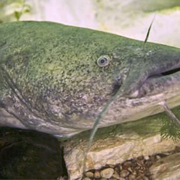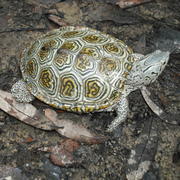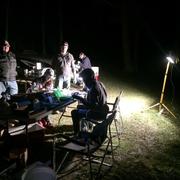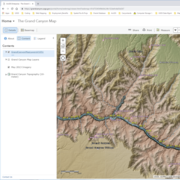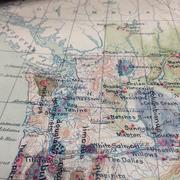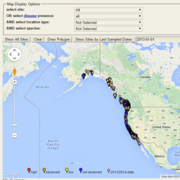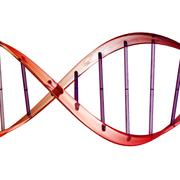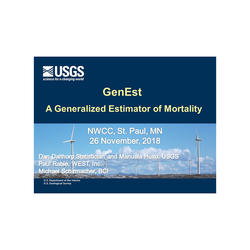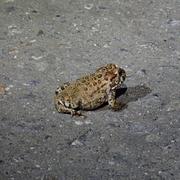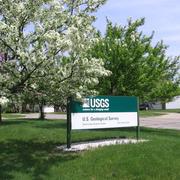Due to a lapse in appropriations, the majority of USGS websites may not be up to date and may not reflect current conditions. Websites displaying real-time data, such as Earthquake and Water and information needed for public health and safety will be updated with limited support. Additionally, USGS will not be able to respond to inquiries until appropriations are enacted. For more information, please see www.doi.gov/shutdown
Mission Areas
Ecosystems
Mission Areas L2 Landing Page Tabs
The USGS Ecosystems Mission Area, the biological research arm of the Department of the Interior (DOI), provides science to help America achieve sustainable management and conservation of its biological resources. This work is done within the broader mission of the USGS to serve the Nation with science that advances understanding of our natural resources and inform land and water stewardship.
The Ecosystems Mission Area provides impartial science information and tools to the Nation’s natural resource managers, with particular focus on the science needs of the Department of the Interior (DOI) and DOI bureaus to manage species, lands and priority ecosystems; fulfill treaty obligations; respond to and reduce threats to natural resources; and manage mineral and energy resources.
Check out our Cool Tools for Hot Topics!
WFRC Ecology Section - Projects Overview
The Ecology Section examines how environmental variability, human activities and infrastructure influence food web interactions and species performance in freshwater and marine ecosystems. We have extensive experience in quantifying aquatic food web processes as they relate to growth, survival and production of key species of interest, especially resident and anadromous salmonids.
Life History and Migration of Sturgeons in New England Waters
Sturgeons appear in the fossil record as early as the Triassic, 200 million years ago. Although most populations could once tolerate harvesting pressures, most populations have collapsed and nearly all of the 28 species alive today are listed as threatened or endangered. In New England, dams and water regulation challenge population recoveries of the two resident species, the shortnose and...
Science Team about Energy and Plains and Potholes Environments (STEPPE)
Brine Contamination to Plains and Potholes Environments from Energy Development in the Williston Basin
Life History of Pacific Northwest Fishes through Age and Growth Structures
The focus of our research is the ecological analysis of Pacific Northwest fishes through age and growth structures such as: scales, fin rays and otoliths (small calcium carbonate deposits beneath the brain used in hearing and balance that grow in proportion to the overall growth of the fish). These structures are utilized as research tools for understanding life histories and habitat...
Human and Ecological Health Impacts Associated with Water Reuse and Conservation Practices
Human and Ecological Health Impacts Associated with Water Reuse and Conservation Practices
Molecular characterization of unknown virus isolated from the introduced species, the Northern snake head (Channa argus), present in the Chesapeake Bay Watershed
Molecular characterization of unknown virus isolated from the introduced species, the Northern snake head (Channa argus), present in the Chesapeake Bay Watershed
Endocrine Disrupting Chemicals and Prevalence of Intersex in Fish Populations in New Jersey
Endocrine Disrupting Chemicals and Prevalence of Intersex in Fish Populations in New Jersey
Evaluating the pathogenicity and replication of a novel aquareovirus that infects the endangered fountain darter, Etheostoma fonticola
Evaluating the pathogenicity and replication of a novel aquareovirus that infects the endangered fountain darter, Etheostoma fonticola
Using Molecular Tools to Recalibrate Freshwater Mussel Taxonomy with a Focus on Imperiled Species
Freshwater mussels of the family Unionidae, also known as naiads, pearly mussels, freshwater clams, or unionids, are a diverse group of bivalve mollusks that are distributed on every continent except Antarctica. Approximately 300 species are known from the United States, with most of this diversity residing in rivers of the Southeast where many endemic taxa have evolved.
Wildlife Tracking/Telemetry
USGS scientists use tracking/telemetry tags to determine the occurrence and local movement patterns of wildlife. Because energy development often takes place in critical wildlife habitats, scientists can study these wildlife patterns to help guide project siting and operational decisions to areas and practices that present the lowest risk to energy development and wildlife.
Management Support Tools
USGS scientists build broadly applicable management support tools to assist resource managers and the industry in siting of energy development and selection of off-site mitigation areas.
Demographic and Population Models
USGS scientists are currently developing models for species of interest that can be overlaid with maps showing areas of potential energy. These models, or map overlays, identify areas of biological strengths and weaknesses or high- and low-quality habitat and can identify opportunities for conservation—areas of high-quality habitat where energy-generating potential is low—and areas of...
Grand Canyon Map Portal
Grand Canyon Map Portal
Click to launch the Grand Canyon Map Portal hosted by the U.S. Geological Survey's Grand Canyon Monitoring and Research Center (GCMRC). GCMRC is part of the River Ecosystem Science branch of the Southwest Biological Science Center (SBSC) and is based in Flagstaff, Arizona.
TEST Data and Tools - Tom Gushue
Grand Canyon Sandbar Monitoring
The Grand Canyon Monitoring and Research Center, in conjunction with Northern Arizona University, monitors changes to sandbars along the Colorado River downstream of Glen Canyon Dam near Page, Arizona. Click here to launch the sandbar monitoring website and associated data applications for this on-going project.
Chinook Salmon Use of Eelgrass Habitats Skagit River Delta Washington
The degree to which eelgrass on river deltas provides critical habitat for estuarine fishes, especially out‐migrating juvenile salmon, is an important scientific and management issue that bears on efforts to conserve and restore both eelgrass and fish.
DATA RELEASE - Spatial distribution and risk analysis data for diamond-backed terrapins relative to crab trapping, Savannah Coastal Refuge Complex, USA - Data
The data collected during the systematic inventory of diamond-backed terrapins includes information on terrapin detection in tidal creeks on refuges, crab pot numbers and locations, and a variety of environmental-, location-, and observer-related variables to examine the effects of both environmental conditions and observer bias on terrapin detection.
Statistical Tools for Wind and Solar Energy Development and Operations
Solar and wind power development is increasing exponentially in the United States. However, these energy sources may affect wildlife, either directly from collisions with the turbine blades or photovoltaic arrays or indirectly from loss of habitat and migration routes. An important component to understanding the effects of these renewable energy projects on wildlife is accurate and precise...
Principal components of climate variation in the Desert Southwest for the time periods 1980-2010, 2040-2070 (RCP8.5) and (RCP4.5) - data release
Five principal components are used to represent the climate variation in an original set of 12 climate variables reflecting precipitation and temperature gradients. The dataset provides coverage for four regions (the Sonoran Desert, Mojave Desert, Colorado Plateau, and Southern Great Basin) and two time periods: current climate (defined as the 1980-2010 normal period) and future climate (...
Climate Distance Mapper - web application
Climate Distance Mapper is a spatial decision-support tool designed to help land managers match seed sources with restoration sites. Plant populations are commonly adapted to local climate gradients and frequently exhibit a home-site advantage. For this reason, climate information may serve as a proxy for local adaptation in restoration designs. Climate Distance Mapper allows users to rank the...
DATA RELEASE - Occurrence records and vegetation type data used for species distribution models in the western United States - Data
These data are species distribution information assembled for assessing the impacts of land-use barriers, facilitative interactions with other species, and loss of long-distance animal dispersal on predicted species range patterns for four common species in pinyon-juniper woodlands in the western United States.
DATA RELEASE - Aeolian mass flux, rangeland monitoring site, and unpaved road reach data - Data
These data were compiled for monitoring and analyzing the amount of windblown (aeolian) sediment at 100 cm height near Moab, UT. Big Springs Number Eight (BSNE) field aeolian passive sediment traps are summarized by location and time period in shapefiles. Shapefiles also include attributes used to analyze patterns in the aeolian transport.
Data collected in 2008-2010 to evaluate juvenile salmon and forage fish use of eelgrass on the Skagit River Delta, Washington State, USA
Data are abundance and body size (length) of juvenile salmon, forage fish, and other species captured with a lampara net in eelgrass and nearby unvegetated habitat on the Skagit River Delta monthly, April-September, 2008-2010, as well as vegetation status, water depth, temperature, salinity, and clarity for each fish netting event.
DATA RELEASE - Climate, hydrology and riparian vegetation composition data, Grand Canyon, Arizona - Data
These data were compiled for monitoring riparian vegetation change along the Colorado River. This file contains data recorded at 42 sandbars between Lees Ferry and Diamond Creek, AZ, which are annually sampled for both geomorphic and vegetation change. Field data contained here were collected from 2012 to 2016 in September and October of each year.
Wildlife Health Bulletins
Wildlife Health Bulletins are distributed to natural resource/conservation agencies to provide and promote information exchange about significant wildlife health threats.
TEST Map - Grand Canyon Poster Map
The Grand Canyon Shaded Relief base map is provided by the Grand Canyon Monitoring and Research (Southwest Biological Science Center) as a resource for identifying and locating importing places of interest along the Colorado River and across the Grand Canyon region.
Grand Canyon Poster Map (GCMRC)
The Grand Canyon Shaded Relief base map is provided by the Grand Canyon Monitoring and Research (Southwest Biological Science Center) as a resource for identifying and locating importing places of interest along the Colorado River and across the Grand Canyon region.
Chronic Wasting Disease Map
Reported distribution of chronic wasting disease (CWD) in North America.
White-Nose Syndrome Occurrence Map
View current and archived maps of white-nose syndrome occurrence by county/district.
Wildlife Health Information Sharing Partnership – event reporting system (WHISPers)
The NWHC developed the Wildlife Health Information Sharing Partnership – event reporting system (WHISPers) to increase public awareness of wildlife disease events and promote collaboration and data sharing among wildlife professionals. It is a partner driven tool that provides a dynamic, timely, searchable web-based system for visualizing and accessing data on wildlife disease events nationwide.
Nonindigenous Aquatic Species Quagga Mussel Sightings Map
Interactive map of the distribution of quagga mussels in North America. This map is provided by the USGS Nonindigenous Aquatic Species program.
Nonindigenous Aquatic Species Zebra Mussel Sightings Map
Interactive map of the distribution of zebra mussels in North America. This map is provided by the USGS Nonindigenous Aquatic Species program.
USGS Cooperative Fish and Wildlife Research Units: 2017 Year In Review
In September 1960, the 86th Congress passed Public Law 86-686 to facilitate cooperation between the Federal government, colleges and universities, the States, and private organizations for Cooperative Unit Programs of research and education relating to fish and wildlife, and for other purposes. The Cooperative Research Units originated in the U.S. Department of Agriculture in the mid 1930s
Sea Star Wasting Syndrome Map
The map includes information from Pacific Rocky Intertidal Monitoring surveys as well as information from logs submitted by other researchers, divers, and the general public.
Movement Maps for Suisun Marsh Waterfowl and Waterbird Studies
Suisun Marsh is a critical habitat for wintering and breeding waterbirds in California. USGS is working with the California DWR to examine the trends in bird decline and to assess the habitat factors driving long-term survival of waterfowl, rails, and other birds in this important area.
Map of USGS WERC Locations
WERC headquarters, field stations, and sub-stations strategically located in or near California and Nevada bioregions, form the core of the WERC science program.
Re-establishing Waterbird Breeding Colonies in San Francisco Bay
This U.S. Geological Survey (USGS), Western Ecological Research Center (WERC) story map details how partners are using science and management to maintain and establish new bird nesting colonies in support of the South Bay Salt Pond Restoration Project. Any use of trade, firm, or product names is for descriptive purposes only and does not imply endorsement by the U.S. Government.
Coastal wetlands: A synthesis
This book and this synthesis address the pressing need for better management of coastal wetlands worldwide because these wetlands are disappearing at an alarming rate; in some countries the loss is 70%–80% in the last 50 years. Managing requires understanding. Although our understanding of the functioning of coastal...
Perillo, Gerardo M. E.; Wolanski, Eric; Cahoon, Donald R.; Hopkinson, Charles S.; Hopkinson, Charles S.; Wolanski, Eric; Cahoon, Donald R.; Perillo, Gerardo M. E.; Brinson, Mark M.Evaluating restored tidal freshwater wetlands
As restoration of tidal freshwater wetlands has progressed in North America and Eurasia, research findings have continued to emerge on the postrestoration success of these ecosystems. The most common approaches used to restore tidal freshwater wetlands involve excavation or placement of dredged sediment to restore tidal ...
Perillo, Gerardo M. E.; Wolanski, Eric; Cahoon, Donald R.; Hopkinson, Charles S.; Baldwin, Andrew H.; Hammerschlag, Richard S.; Cahoon, Donald R.Movement ecology of reintroduced migratory Whooping Cranes
No abstract available.
Teitelbaum, Claire S.; Converse, Sarah J.; Fagan, William F.; Mueller, ThomasReproduction and reproductive strategies relevant to management of Whooping Cranes ex situ
Due to the small population size (∼400 birds) and continuing threats to wild Whooping Cranes (Grus americana), an ex situ (captive) population is maintained to contribute to the recovery of the species. The goals of the captive breeding program are to provide opportunity for research and birds for reintroduction. However, reproduction...
Songsasen, Nucharin; Converse, Sarah J.; Brown, MeganPopulation dynamics of reintroduced Whooping Cranes
Because of the small size and restricted range of the Aransas-Wood Buffalo Population, reintroduction is a prominent element of the recovery effort to ensure persistence of Whooping Cranes (Grus americana). A fundamental objective of all Whooping Crane reintroduction efforts is the establishment of a self-sustaining population. Therefore...
Converse, Sarah J.; Servanty, Sabrina; Moore, Clinton T.; Runge, Michael C.Whooping Cranes past and present
The Whooping Crane (Grus americana), endemic to North America, is the rarest of all crane species. It is believed that in the early 1800s, the Whooping Crane was widespread in North America, though it was never very abundant. Whooping Crane numbers decreased precipitously as westward migration of Euro-American settlers converted ...
French, John B.; Converse, Sarah J.; Austin, Jane E.Reproductive failure in the Eastern Migratory Population: The interaction of research and management
The reintroduction of the Eastern Migratory Population of Whooping Cranes (Grus americana) has shown the most promise of any effort to date toward the establishment of a self-sustaining population. However, reproduction – including both nest success and chick survival – has been a major challenge. Here, we review the research and...
Converse, Sarah J.; Strobel, Bradley N.; Barzen, Jeb A.2017-2018 Palila abundance estimates and trend
The palila (Loxioides bailleui) population was surveyed annually from 1998–2018 on Mauna Kea Volcanoto determine abundance, population trend, and spatial distribution. In the latest surveys, the 2017population was estimated at 1,177−1,813 birds (point estimate: 1,461) and the 2018 population wasestimated at 778−1,420 (point estimate: 1,051). Only...
Genz, Ayesha S.; Brinck, Kevin W.; Camp, Richard J.; Banko, Paul C.Optimization of salt marsh management at the Bombay Hook National Wildlife Refuge, Delaware, through use of structured decision making
Structured decision making is a systematic, transparent process for improving the quality of complex decisions by identifying measurable management objectives and feasible management actions; predicting the potential consequences of management actions relative to the stated objectives; and selecting a course of action that maximizes the total...
Neckles, Hilary A.; Lyons, James E.; Nagel, Jessica L.; Adamowicz, Susan C.; Mikula, Toni; Guiteras, Susan T.; Mitchell, Laura R.Identification of bees in southwest Idaho—A guide for beginners
This document was prepared to help scientists and the public, both of whom may not be familiar with bee taxonomy, learn how to practically identify bees in sagebrush steppe and shrubland habitats in southwest Idaho. We provide information to identify bees to the level of family and genus. A tentative list of the bee genera captured at sites used...
Sun, Emily R.; Pilliod, David S.Eco‐evolutionary rescue promotes host–pathogen coexistence
Emerging infectious pathogens are responsible for some of the most severe host mass mortality events in wild populations. Yet, effective pathogen control strategies are notoriously difficult to identify, in part because quantifying and forecasting pathogen spread and disease dynamics is challenging. Following an outbreak, hosts must cope with the...
DiRenzo, Graziella V.; Zipkin, Elise F.; Campbell Grant, Evan H.; Royle, J. Andrew; Longo, Ana V.; Zamudio, Kelly R.; Lips, Karen R.Waterfowl spring migratory behavior and avian influenza transmission risk in the changing landscape of the East Asian-Australasian Flyway
Avian influenza has advanced from a regional concern to a global health issue with significant economic, trade, and public health implications. Wild birds, particularly waterfowl (Anseriformes), are known reservoirs for low-pathogenic avian influenza viruses (AIV) and recent studies have shown their potential in the spread of highly pathogenic...
Sullivan, Jeffery D.; Takekawa, John Y.; Spragens, Kyle A.; Newman, Scott H.; Xiao, Xiangming; Leader, Paul J.; Smith, Bena; Prosser, Diann J.GenEst - A Generalized Estimator of Mortality
GenEst, a generalized estimator of wildlife mortality at renewable energy facilities.
SSR_pipeline: Computer Software for the Identification of Microsatellite Sequences from Paired-End Illumina High-Throughput DNA Sequence Data
SSR_pipeline is a flexible set of programs designed to efficiently identify simple sequence repeats (SSRs; for example, microsatellites) from paired-end high-throughput Illumina DNA sequencing data.
fatalityCMR
Capture-recapture software to correct raw counts of wildlife fatalities using trial experiments for carcass detecition probability and persistence time.
Evidence of Absence (EoA) Software and User's Guide
Software to Estimate Bird and Bat Fatality at Wind Farms
AquaPathogen X: A Template Database for Tracking Field Isolates of Aquatic Pathogens
Aquatic Pathogen Template Database (AquaPathogen X)
Wildlife Software and Models
A suite of software tools and models developed by Colorado State University and the USGS Colorado Cooperative Fish And Wildlife Research Unit.
monitoR: Acoustic template detection in R
Tools for automated acoustic monitoring of nature.
Fishery Information and Technology Software
Software from the American Fisheries Society
R for Fisheries and Wildlife Applications
FW599: An introduction to data management and R for Fisheries and Wildlife applications--- a lighthearted look
InVEST: 18 different models for ecosystem services
The InVEST tool allows researchers to evaluate relationships between land management actions and wild bee populations.
Fatality Estimator Software
Tool to Evaluate Wildlife Fatalities at Wind-Power Facilities
CloseTest
CloseTest is a Windows program for testing capture-recapture data
Cuban treefrog - Osteopilus septentrionalis
Can you hear the difference between the non-native Cuban treefrog and two common Louisiana native treefrogs? Cuban treefrogs’ call is distinctive. Biologist Paul Moler of the Florida Fish and Wildlife Conservation Commission recorded them in South Florida. Credit: Paul Moler, used with permission.
Green treefrog - Hyla cinerea
Green treefrogs call from their favorite habitat, rivers and lakes. They’re native to Louisiana and Florida, where these were recorded. Credit: Paul Moler, used with permission.
Map of AK showing probability of change occurrence
Map of Alaska showing probability (%) of change occurrence. Insets show fire boundaries from the Bureau of Land Management (BLM) Large Fire Database and Landsat 8 imagery (bottom right; 2016) north of Fairbanks, Alaska.
Squirrel treefrog - Hyla squirella (Marion)
Squirrel treefrogs are also native to Florida and Louisiana. Hear them calling from ditches, puddles and other ephemeral pools of water. Credit: Paul Moler, used with permission.
Male leafcutting bee (Megachile) approaching an Origanum
The alfalfa leafcutting bee (Megachile rotundata) is an introduced species common to Southwest Idaho. They originate from the old world, most likely from northeastern Africa or the Middle East. These bees are successful pollinators of various crops and have been imported to North America for use in agriculture and beekeeping.
Juvenile Salt Marsh Harvest Mouse (Reithrodontomys raviventris)
USGS wildlife biologists holding a juvenile salt marsh harvest mouse (Reithrodontomys raviventris). The species is listed as "endangered" under the Endangered Species Act of 1973.
Slide 1 26Nov2018 NWCC GenEst Workshop
Opening slide for the Intro to GenEst, A Generalized Estimator of Mortality, Workshop held at the National Wind Coordinating Collaborative's Wind Wildlife Research Meeting XII on November 26, 2018 in St. Paul Minnesota. https://www.nationalwind.org/meetings/wind-wildlife-research-meeting-
...RestoreNet treatments
RestoreNet locations are testing commonly used restoration techniques, including pitting, mulching, and above-ground micro sites. Here, pits have filled with water, illustrating how this technique increases soil moisture by capturing rainwater. The project will illustrate which techniques work to establish plants depending on local conditions (like soil type) and climate
...RestoreNet treatments
RestoreNet locations are testing commonly used restoration techniques, including pitting, mulching, and above-ground micro sites. Here, metal crosses create an above-ground microsite that can increase soil moisture by providing shade and collecting debris under some conditions. The project will illustrate which techniques work to establish plants depending on local
...RestoreNet treatments
RestoreNet locations are testing commonly used restoration techniques, including pitting, mulching, and above-ground micro sites. This photo shows the mulching treatment, which can increase soil moisture and lead to higher plant survival under some conditions. The project will illustrate which techniques work to establish plants depending on local conditions (like soil
...Pacific fisher trying to grab a chicken dinner from the bait box
USGS scientists are documenting the distribution of three mid-sized mammalian carnivores – or mesocarnivores –in the Klamath Network Parks using remote cameras and hair snares. Little is known about the status of Pacific fishers, Pacific martens, and Sierra Nevada red foxes living in the Klamath Network, which include Crater Lake National Park, Lassen Volcanic National
...Figure 1, Horn, et al. (2018)
Gradients of N deposition, S deposition, mean annual temperature, and mean annual precipitation across the conterminous U.S. Panels are the a) mean total N deposition from 2000–2012, b) mean total S deposition from 2000–2012, c) mean annual temperature from 2000–2014, and d) mean annual precipitation form 2000–2014. Deposition data are from the TDEP product [23] and
...How Hurricanes Michael, Florence May Have Spread Nonnative Species
USGS’ preliminary storm trackers show potential for subtle damage in natural areas
Honey Bee Helpers: It Takes a Village to Conserve a Colony
Do you eat fruits and vegetables? What about nuts? If so, you can thank an insect pollinator, usually a honey bee. These small insects play a major role in pollinating the world’s plants, including those we eat regularly. They also increase our nation’s crop values each year by more than 15 billion dollars.
Where Have All the Turtles Gone, and Why Should We Care?
A recently published paper on the global status of turtles and their ecological roles generated quite a bit of media interest.
Identifying Potential Contaminant Exposure to California Condors in the Pacific Northwest
Potential reintroduction of the endangered California Condor to parts of its historic range in the Pacific Northwest would benefit from information on possible threats that could challenge recovery efforts. Exposure to environmental contaminants is a key limiting factor for condor recovery in its southern range.
Cool Tools & Ready Resources for Hot Science
With labs that rival those of your favorite crime scene investigator and tech that would make even the most resourceful problem-solving secret agent jealous, the USGS is developing and using tools that help answer some of the most pressing questions being asked by wildlife, natural resource, and land managers. Here are just a few:
Toad Crossing Ahead: New Study Tests Elevated Roads as Underpasses for Rare Toad
Many amphibians are either too small or too slow to avoid an oncoming car. For some populations of the Federally threatened Yosemite toad (Anaxyrus canorus), this has meant increased mortality from vehicle strikes in addition to other threats from disease, drought, and habitat loss.
Genetic Analysis of Florida's Invasive Pythons Reveals A Tangled Family Tree
A new genetic analysis of invasive pythons captured across South Florida finds the big constrictors are closely related to one another. In fact, most of them are genetically related as first or second cousins, according to a study by wildlife genetics experts at the U.S. Geological Survey.
USGS Scientist Dr. Craig D. Allen Named Ecological Society of America Fellow
The U.S. Geological Survey is celebrating the achievements of Dr. Craig D. Allen, who was recently named an Ecological Society of America (ESA) fellow for making exceptional contributions to a broad array of ecology. Dr. Allen, a research ecologist with the USGS Fort Collins Science Center, joins 27 other newly-initiated ESA fellows from academia, public and private sectors. Fellows are elected for life.
Born in a Los Angeles zoo, released into the San Gabriels, a rare frog bounces back (The LA Times)
SAN GABRIEL MOUNTAINS, CA — Last week, biologists from the USGS Western Ecological Research Center (WERC) and partnering agencies released hundreds of endangered, mountain yellow-legged frog tadpoles back to their historic habitat in southern California.
New Approach May Detect Chronic Wasting Disease Earlier, at Less Cost
A new statistical approach to disease surveillance may improve scientists’ and managers’ ability to detect chronic wasting disease earlier in white-tailed deer by targeting higher-risk animals. This approach can also provide financial and personnel savings for agencies that are required to monitor for wildlife diseases, including the National Park Service, or NPS.
It’s National Pollinator Week! Get the buzz on USGS pollinator research
Bees, birds, butterflies, bats and beetles provide vital but often invisible pollination services that support terrestrial wildlife and plant communities, and healthy watersheds.
USGS Hurricane Response Met Challenges in 2017, Prepares for 2018
No one has a crystal ball to foresee what will happen during the 2018 hurricane season that begins June 1, but NOAA forecasters say there’s a 75 percent chance this hurricane season will be at least as busy as a normal year, or busier.
Ecosystems provides scientific information and decision support to meet Interior’s shared responsibility to manage land and species, fulfill treaty obligations, develop energy and mineral resources on Interior lands, and supply water for irrigation and other human needs. Our main Interior Department partners are listed below. Additional partners are listed throughout our web pages.





